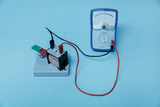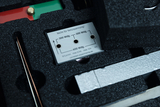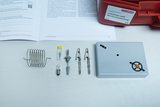Physics experiments on induction and alternating current
Experiments on the interaction of magnetism and electricity for 6 learning groups
With these high-quality materials, students from grade 9 onwards can carry out important experiments on the topic of induction and alternating voltage themselves. Motivated by captivating examples from everyday life, they safely work out with this class set how magnetism and electricity interact. For example, what happens in a coil when electricity flows through it? How do the magnetic fields around a current-carrying conductor and a coil differ?
Special features
- All student experiments are developed according to safety regulations: current limit < 3 A, voltage up to 12 V, output voltage at the transformer up to 4 V AC
- The U-I core is available six times in the class set for parallel work by the learning groups.
- The completeness of the experiment materials can be checked at a glance.
Tip: For the self-induction experiment, you also need some parts that are not included in the 54075 class set (see accessories). Alternatively, you can find all these small parts in the supplementary set 54076.
In the accompanying material
- The teacher's manual is didactically prepared and suitable for immediate use.
- All student worksheets are available as editable Word versions for free download.
- The experiments are enriched with a list of materials, instructions for carrying them out, evaluation and tips for you as a teacher. QR codes for internal differentiation, hint boxes, formula support and many 3D illustrations offer individual help to the learners.
Topics that are additionally covered
- Magnetic fields of current-carrying conductors and coils
- Induction in coils
- Generator
- Transformer
- Lenz's rule
- Delayed switch-on process with parallel connection of L and R, switch-on and switch-off processes with coils
- Impedance
A compass is used to study the magnetic field of a coil with 8 turns caused by an electric current (2 A).
The evaluation also addresses the influence of the Earth's magnetic field on the observation.
The influence of the coil parameters winding number, current and permeability on the strength of the magnetic field is qualitatively investigated. The strength of the magnetic field is assessed according to how strongly an iron sheet strip is attracted to the upper end of an I-core located in the coil.
In four small sub-experiments, it is investigated how the highest possible voltage can be induced with permanent magnets and a coil.
The amount of the voltage is determined by the deflection of a electroplating or multimeter directly connected to the coil.
A rotatable permanent magnet is rotated in front of a coil. The AC voltage generated in the coil is supplied with a galvanometer directly connected to the coil.
In an unloaded transformer, primary and secondary voltage are measured with two multimeters.
In the evaluation, the legal relationship between the measured voltages and the number of turns of the coils is independently discovered.
A compass is used to study the magnetic field of a copper wire caused by an electric current. In addition to the classical findings from the Ørsted experiment, the disturbing influence of the Earth's magnetic field on this experiment is also addressed.
A bar magnet is quickly moved into a free-hanging aluminum ring. Subsequently, the observations are traced back to the law of induction and Lenz's rule.
The influence of a coil on the switch-on and switch-off process is observed in simple circuits of switches, lamps and LEDs.
With a function generator, the inductance with and without iron core is indirectly determined via a measuring resistor.
- 18 × Magnet rod, AlNiCo, 23 mmwith red-marked northpole
- 1 × Sewing thread, 100 m
- 6 × Crocodile clip, bare
- 12 × Crocodile clip with 4 mm plug
- 6 × Electrode support on plug
- 6 × Short circuit ring, 40 mm
- 1 × Plastic case ca.540x450x150 mm
- 6 × Magnet bar/brass bearing AlNiCo, 72 x 60 x 6 mm
- 6 × Needle support with plug
- 2 × Copper wire, supple 1,5mm(450 mm long)
- 1 × Bulb, MES, 4 V/1 A clear set of 10 pcs.
- 6 × U-and I-core with clamp screw, student type
- 6 × Coil with 1200 turns student type
- 6 × Coil with 600 turns student type
- 1 × Welding strips, 10 pcs.
- 6 ×
- 6 ×
- 6 ×
- 6 ×
- 6 ×
- 1 ×
- 1 ×
- 1 ×






















